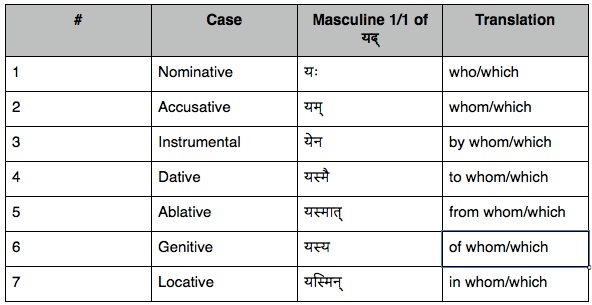|
Exercise Page 178
|
|
Relative Pronoun
The relative pronoun 'यद्' is formed by adding the the letter 'य्' to the common pronoun endings. (Common pronoun endings were presented in a chart in Lesson 7.) Although its translation varies, basic translations are tabulated below, using the masculine singular forms as examples:
For example, the sentence "यस्मिन् प्रासादे नृपः वसति, सः अस्याः नद्याः तीरे तिष्ठति" can be translated "In which palace the king lives, it stands on the bank of this river". When translating relative pronouns, the following two points should be kept in mind:
- A relative pronoun must always be paired with a correlative pronoun (usually तद्). For example, the phrase 'In which palace the king lives...' is not a complete sentence. It must be followed with a phrase using a correlative pronoun, such as '... it stands on the bank of this river'.
- The relative-correlative pronoun pair must refer to the same noun. In the example above, the 'यस्मिन्' and the 'सः' both refer to the palace. Therefore, the two pronouns are usually of the same gender and number. However the case of each pronoun depends on its role in the phrase in which it is found. In this example, the relative pronoun indicates the location of the verb वसति, whereas the correlative pronoun is the subject of the verb तिष्ठति.
Regressive Assimilation Sandhi
Regressive assimilation sandhi takes place when a word (including a noun stem within a compound, and a prefix to a verb) ends in a consonant. The consonant must be changed so it 'matches' the following letter. This 'matching' can be based on voicing alone (called partial regressive assimilation) or both voicing and place of articulation (called full regressive assimilation). It may be useful to review the properties of the alphabet using the chart below:
| Alphabet Chart | |
| File Size: | 68 kb |
| File Type: | |
Voicing properties (i.e. voiced versus unvoiced) are indicated in the second row of the chart. Places of articulation (i.e. guttural, palatal, cerebral, dental, and labial) correspond to the rows of the letters of the alphabet. For example, the letter द् is voiced and dental.
Words do not end in aspirated consonants. Therefore, partial regressive assimilation amounts to switching between the first (unvoiced, unaspirated) and third (voiced, unaspirated) columns within a row of consonants. For example, if the letter द् is followed by the letter क् (which is unvoiced), the द् changes to an unvoiced letter to 'match' the क्. The unvoiced, unaspirated consonant in the same row as द् is त्. Hence तद् करोति becomes तत् करोति. In contrast, no change would happen between तद् अगच्छत्, because the अ following the द् is voiced, so द् already 'matches' it.
In full regressive assimilation, an additional step takes place when a dental consonant (त् or द्) is followed by a palatal consonant. After undergoing partial regressive assimilation to match voicing, the dental consonant turns into the palatal consonant, i.e. same column, two rows up. For example, if द् is followed by छ् (which is unvoiced), it first becomes त् to match the voicing of छ्. Then त् becomes च् to match the place of articulation of छ्. Hence तद् छाया becomes तच् छाया.
Words do not end in aspirated consonants. Therefore, partial regressive assimilation amounts to switching between the first (unvoiced, unaspirated) and third (voiced, unaspirated) columns within a row of consonants. For example, if the letter द् is followed by the letter क् (which is unvoiced), the द् changes to an unvoiced letter to 'match' the क्. The unvoiced, unaspirated consonant in the same row as द् is त्. Hence तद् करोति becomes तत् करोति. In contrast, no change would happen between तद् अगच्छत्, because the अ following the द् is voiced, so द् already 'matches' it.
In full regressive assimilation, an additional step takes place when a dental consonant (त् or द्) is followed by a palatal consonant. After undergoing partial regressive assimilation to match voicing, the dental consonant turns into the palatal consonant, i.e. same column, two rows up. For example, if द् is followed by छ् (which is unvoiced), it first becomes त् to match the voicing of छ्. Then त् becomes च् to match the place of articulation of छ्. Hence तद् छाया becomes तच् छाया.
NOTE: A few additional rules of regressive assimilation sandhi exist that are not explicitly mentioned in the book. These are:
- When a dental consonant is followed by a cerebral consonant, it undergoes full regressive assimilation, e.g. तद् टीका becomes तट् टीका
- When a dental consonant is followed by श्, after full regressive assimilation has taken place, the श् becomes छ्, e.g. तद् शास्त्रम् becomes तच् छास्त्रम् - this is an example of progressive assimilation
- When a dental consonant is followed by ल्, the dental consonant optionally becomes ल्, e.g. विद्युत् लता becomes विद्युल् लता
- When a consonant is followed by a nasal letter (i.e. ङ्, ञ्, ण्, न्, or म्), the consonant optionally becomes the nasal letter of the same place of articulation, e.g. तद् मित्रम् becomes तन् मित्रम्

